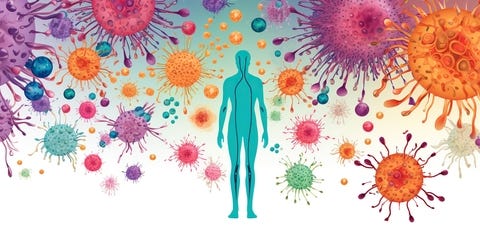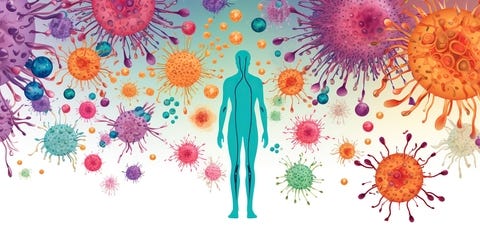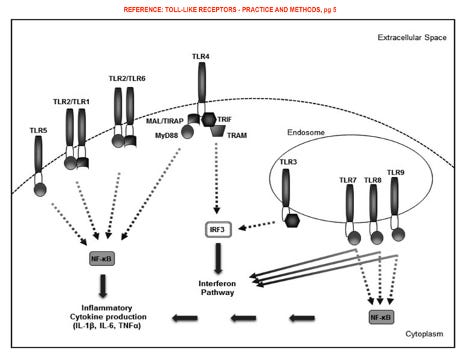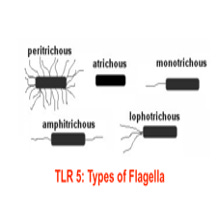Follow: Twitter | Instagram | Telegram | Truth Social | Podcast Membership|
Broadcasts: Rumble| HappyHour |This Wk wDrT | Brighteon | Bitchute | Tues Coffee
Learn about ECP: Health Center Cleveland, OH | Health Center Ventura, CA
Websites: DrTenpenny.com |Tenpenny Apparel| Tenpenny Supplements
Photo 304797259 © Koldunova | Dreamstime.com
Over the last few weeks, we’ve explored how the different forms of antibodies respond to foreign proteins (bacteria, parasites, etc) and foreign matter injected into the body as a vaccine. In case you missed them, you can find articles on IgG, IgA, IgM, IgE and IgD at their respective links.
These components are part of what is called the adaptive immune system. Other than antibodies that are transferred to a baby in utero from its mother, the immune system begins to adapt as soon as s/he is exposed to particles in the environment.
The other arm of the immune system is known as the innate immune system. Innate immunity is the body’s first line of defense designed to prevent infection, eliminate invading pathogens, and stimulate the acquired immune response. Considered to be a “nonspecific mechanism” of defense, all components of the inborn immune system act in a coordinated response by reacting very quickly (minutes to hours), while the adaptive response takes longer (days to weeks). This very complex and beautiful system we were born with is comprised of many different components including (here’s a good table to summarize all the components)
physical barriers
phagocytic (cell-destroying) enzymes such as lysozymes
white blood cells (macrophages, neutrophils, monocytes, mast cells, natural killer cells, dendritic cells)
inflammatory proteins (complement, C-reactive protein, cytokines), and
a group of very specialized proteins called Toll-like receptors.
For this discussion, we will be focusing on the Toll-like receptors, which I have long defined as “God within us.”
Toll-like receptors (TLRs)
Before the discovery of Toll-like receptors (TLRs), innate immunity was seen as an unsophisticated part of the immune system. Immunologists thought its only purpose was as a precursor to what they believed to be as the more sophisticated adaptive immune response. The adaptive immune response has been the focus of all vaccines; developing a “protective IgG antibody” was thought to be the cornerstone of protection against all types of infectious diseases.
In 1989, Dr. Charles Janeway, MD who spent his career doing immunological research, proposed a general theory of innate immune recognition called Pattern Recognition Theory. Janeway proposed what was then an unorthodox belief that the immune system evolved not simply to discriminate self from non-self, as in organ transplant science, but has a way of distinguishing between “noninfectious self from infectious non-self.” Janeway predicted there was a missing piece to bind the entire immune system together and this mechanism was yet to be discovered.
More than 10 years later, in 1996, toll-like receptors were discovered and first characterized in fruit flies. Drs. Hoffmann and Buetler demonstrated that in Drosophila (fruit flies), a protein called Toll was required for flies to generate an effective immune response to protect them from being overrun and killed by the fungus Aspergillus fumigatus. This study made scientists aware that it was the innate immune system functions as a pathogen detector. The following year, in 1997, the first human TLR was discovered. This important receptor was later named TLR4.
At about the same time, another important researcher, Ralph Steinman, MD was studying the new field of cell-mediated immunity. In 2011, he was awarded the Nobel Prize in Physiology or Medicine for his discovery of the dendritic cell and its role in adaptive immunity. He shared the award with Beutler and Hoffmann for their discoveries concerning the activation of innate immunity and the identity of the Toll-like receptors.
NOTE: The discovery of TLRs is VERY new science. The original discovery was less than 30 years ago, while modern-day vaccination, starting with Jenner, with random activation of the adaptive immune system to produce IgG antibodies has been around for more than 225 years.
With the discovery of Toll-like receptors, it was shown that TLRs play a central role in innate immunity, overall health, and long-term well-being. To date, 222 TLRs have been identified in invertebrates and 28 TLRs in vertebrates but only 10 TLRs have been identified in humans.
TLR 1, 2, 4, 5, and 6 are located on the surface of every cell of our internal organs.
TLR4 was the first to be discovered and reported to regulate the inflammatory responses.
TLR 3, 7, 8, and 9 are found inside every one of our cells.
This table identifies which TLR reacts to which type of pathogen – bacteria, fungus, parasites, viruses, or synthetic compounds,
I know this is a deep dive into immunology, but hang in with me! This is REALLY important.
Reference: https://link.springer.com/book/10.1007/978-1-4939-3335-8
Pattern Recognition
While the TLRs cannot precisely identify a particular microbe, by using pattern recognition, they detect lipopolysaccharides found on the surface of bacteria. This leads to an inflammatory cascade to clear the unwanted pathogen.
The body’s natural barriers include the skin, mucous membranes, stomach acid, mucus in the entire GI tract, tears, and earwax. The normal flow of urine washes out microorganisms that enter the urinary tract. However, unwanted bacteria, viruses, protozoa, yeast, etc., can by-pass these barriers all day long through the course of activities: teeth brushing, having a bowel movement, having sex, cutting your finger.
TLRs hold a key position in the first line of defense because of their ability to recognize the pattern of the pathogen: Is it a bacteria? Is it a pathogen with a tail (a flagellin)? Is it a parasite?
When a pathogen gets into the bloodstream, the TLRs get busy. These divinely designed, hypervigilant little proteins work 24/7/365 to eliminate foreign pathogens, with little or no fanfare. Only when they can’t get rid of the contaminant or get overwhelmed do they heighten the response, send out cytokine signals to “call in the troops,” create a fever, and activate the entire immune cascade.
If you're interested in more detail, this article has some very good pictures/diagrams to explain these reactions further.
It is important to note that antibodies, especially IgG are part of the adaptive immune response, are really the clean-up crew; they are the last players to join the game.
This is why the immediate injection of synthetic vitamin K and one of several hepatitis B vaccines at the time of birth is so detrimental to a newborn. Here are some of the ingredients in the two newest, most popular Hep B vaccines in use:
PreHevBrio: 8 mg/salt (burns); disodium hydrogen phosphate dodecahydrate which is used in desserts/puddings and instant Jell-O for thickening; Aluminum 500 mcg; residual amount of Chinese Hamster Ovary Cells (CHO), bovine serum, and formaldehyde
HepLisav-B: yeast cells, yeast DNA, polysorbate 80, and 3000 mcg of CpG1018 (a new adjuvant with no experience for use in infants). This adjuvant interfaces with TLR 9, discussed below.
HOW do TLR neutralize pathogens? A few examples...
Look at the complexity of this diagram. Follow the arrows. This diagram shows what happens when the LPS on the surface of an E. coli bacteria is identified and TLR4 is activated. It shows how ONE bacteria, an E.coli that most likely migrated from the colon into the blood, is eliminated.
Another toll-like receptor, TLR5, is highly specific. It is responsible for the recognition of flagellated bacteria (bacteria with a tail)
TLR5 may play a role in inflammatory bowel disease (IBD) and in the breakdown of bone in osteopenia. Patients with severe ulcerative colitis have statistically significant lower levels of TLR5 on cell surfaces.
God Within Us
Again, TLRs recognize pathogens by the PATTERNS on the surface of the invader. I don’t know about you, but I find that astounding.
Each receptor is unique to each TLR. For example, none of the other nine TLRs can recognize foreign bacteria with a flagella; only TLR5. Among the 10 TLR family members reported, only TLR2, TLR4, TLR5 and TLR9 can recognize different components of bacteria. The other TLR do other things, together or in combination. That’s why they are called pattern recognition receptors (PRRs).
All PRRs can sense the difference between unfamiliar blood proteins and molecules, such as naturally occurring lipids, carbohydrates, and nucleic acids. These are the key components of our inborn (innate) immune system. When the TLRs are activated, they send out signals that lead to cell death and clean up (phagocytosis) of unwanted pathogens and other invaders (refer again to the diagram above).
More Manipulation of God’s creation
Instead of respecting the awe in nature of this complex and beautiful system, and respecting the inherent properties of TLR signaling, researchers started looking at developing vaccine adjuvants to manipulate the Toll-like receptors. This is what is already in process:
(paraphrased from “TLR Agonists as Vaccine Adjuvants Targeting Cancer and Infectious Diseases.” January 2021. PMID: 33499143)
TLR agonists have emerged as highly potent (strong) activators of the innate immune system. A number of vaccine adjuvants and immunomodulatory agents against both infectious diseases and cancer have already been developed. For example, adjuvants that activate TLR4 have been approved as part of several vaccines: Cervarix against cervical infections, Shingrix against shingles, and Fendrix against Hepatitis B. Other TLR4 agonists (activators) are being tested for other vaccines, allergy shots, and treatments for cancer.
Similarly, an adjuvant that activates TLR9 agonist is already included in Heplisav-B (hep b vaccine) and is being investigated for use in other vaccines and for cancer modulation. It is worth noting that TLR4 and TLR9 agonists were discovered first, which might explain their advanced development as vaccine adjuvants.
Two of the tenets of osteopathic medicine are 1) the body is a unit; a person is a unit of body, mind, and spirit, and 2) the body is capable of self-regulation, self-healing, and health maintenance.
God created a beautiful system—the entire, complex immune system—to keep us healthy and well with very little fuss or effort if we eat real food, drink purified water, avoid food additives, and avoid as many toxic chemicals as possible. There’s no way that systems this complicated arose by accident over billions of years as we emerged from the “primordial soup.”
Take care of it, and it will take care of you.








Vitamin D is the master hormone that regulates both the innate and adaptive immune systems. Yet, we’ve been conditioned to fear the sun and its vitD, causing chronic inflammation...and customers for “life” for big pharma poisons to treat the resultant autoimmune diseases☠️
The immune system was the target of the covid vaccines. The shots shut down parts of our immunity as not being able to recognize serious pathogens it would before the shots.
Del Bigtree spoke extensively on this 2 years ago.